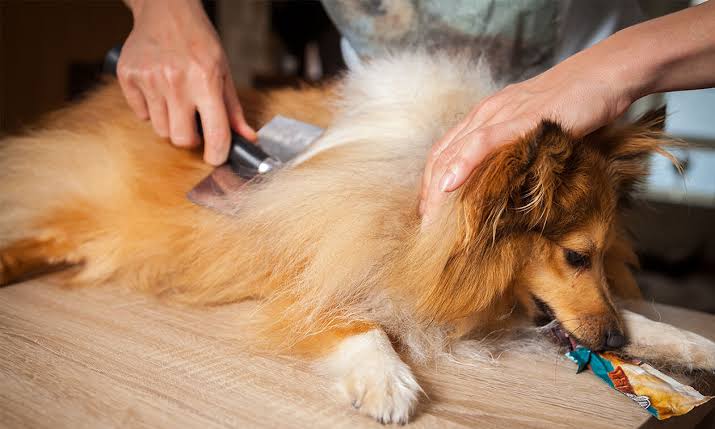
How to Reduce Shedding in Pets
This article provides practical tips and techniques for reducing shedding in pets. It covers various aspects of pet care, including regular brushing, proper diet, bathing techniques, and environmental management, to help pet owners minimize shedding and maintain a cleaner home.
🐶 Pet Star
13 min read · 1, Feb 2025

Understanding the Shedding Cycle
First, my dear, it's important to understand why pets shed. Shedding is a natural process. It's how pets get rid of old or damaged hair to make way for new, healthy growth. The amount of shedding varies depending on the breed, the season, and the individual pet. Some breeds, like Huskies or Persian cats, are naturally heavy shedders, while others shed less. Seasonal shedding, often called "blowing coat," usually occurs in the spring and fall when pets shed their winter or summer coats.
The Power of Regular Brushing
Now, the most important weapon in the fight against shedding is regular brushing. Oh, brushing is so crucial! It removes loose hair before it ends up on your furniture, clothes, and floors. It also helps prevent mats and tangles, which can be painful for your pet. The type of brush you use depends on your pet's coat. For short-haired pets, a slicker brush or a rubber grooming mitt works well. For long-haired pets, you might need a de-shedding tool or a comb with long teeth. Be gentle, especially around sensitive areas like their belly and ears. Think of it as a bonding experience, a little massage for your furry friend.
Diet and Nutrition: Fueling a Healthy Coat
A healthy diet plays a vital role in coat health and shedding. Make sure you're feeding your pet a high-quality food that's appropriate for their age, breed, and activity level. Look for foods that are rich in omega-3 and omega-6 fatty acids, which are essential for healthy skin and fur. These fatty acids can help reduce shedding and make your pet's coat shiny and lustrous.
Bathing: The Right Way to Wash Away Shedding
Bathing can also help reduce shedding, but it's important not to overdo it. Bathing your pet too frequently can dry out their skin and actually increase shedding. Use a pet-specific shampoo and lukewarm water. After the bath, be sure to dry your pet thoroughly to prevent skin problems. You can even use a blow dryer on a cool setting, but keep it at a distance and be careful not to burn them.
Managing the Environment: Minimizing Hair Around the House
Beyond grooming and diet, there are things you can do around your home to minimize shedding. Regular vacuuming is essential. Use a vacuum cleaner with a good filtration system to trap pet hair. You can also use lint rollers or sticky tape to remove hair from your clothes and furniture. Consider using washable slipcovers on your furniture to protect it from pet hair.
Supplements and Remedies: Extra Support for Coat Health
There are also supplements and remedies available that can help reduce shedding. Consult with your veterinarian before giving your pet any supplements. They can recommend the best products for your pet's individual needs.
When to Consult a Veterinarian: Addressing Excessive Shedding
While some shedding is normal, excessive shedding can be a sign of an underlying health problem. If your pet is shedding excessively, or if you notice any other symptoms like skin irritation, hair loss, or changes in behavior, it's important to consult with your veterinarian. They can rule out any medical conditions and recommend appropriate treatment.
Patience and Consistency: The Key to Success
Reducing shedding isn't an overnight fix. It takes time, patience, and consistency. Make brushing, proper diet, and regular cleaning a part of your routine. With a little effort, you can manage shedding and keep your home cleaner and your pet happier.
Q&A Section:
Q1: My dog sheds year-round. Is this normal?
Ans: Some shedding throughout the year is normal for most dogs. However, if the shedding is excessive or accompanied by other symptoms, it's best to consult with your vet.
Q2: What kind of brush is best for my short-haired cat?
Ans: A slicker brush or a rubber grooming mitt is usually a good choice for short-haired cats.
Q3: Can I use human shampoo on my dog?
Ans: No, you should never use human shampoo on your dog. Human shampoo can be too harsh and can disrupt the pH balance of your dog's skin. Always use a shampoo specifically formulated for dogs.
Q4: How often should I bathe my pet?
Ans: Bathing frequency depends on your pet's breed, lifestyle, and coat type. In general, bathing every few months is sufficient for most pets unless they get particularly dirty. Over-bathing can lead to dry skin and increased shedding.
Q5: Are there any home remedies for reducing shedding?
Ans: A healthy diet rich in omega fatty acids can help.
Similar Articles
Find more relatable content in similar Articles
Explore Other Categories
© 2024 Copyrights by rPets. All Rights Reserved.